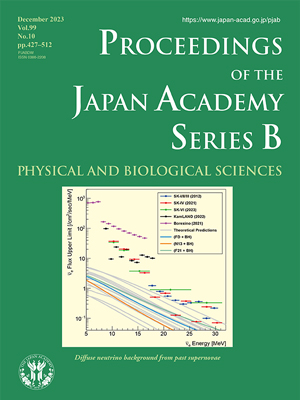About the Cover
Vol. 99 No. 10 (2023)
Core-collapse supernovae are among the most powerful explosions in the Universe. In these events, elements heavier than helium, which are essential for the existence of life, are produced and diffused into the Universe. Therefore, the study of supernova explosions can answer the fundamental questions such as why the Universe exists and why we are here. In particular, the observation of neutrinos, which are responsible for >99% of the energy emitted by a supernova, is crucial because they provide valuable insights into core-collapse modeling, neutrino physics, and cosmic supernova rate history. However, due to the extremely weak interaction of neutrinos with matter, to observe neutrinos from a supernova, the explosion must happen considerably close to the Earth, and SN1987A—which occurred in the Large Magellanic Cloud in 1987—is the only observation to date. Supernova explosions near the Earth are rare. Observing the supernova explosions near the Earth is not the only approach for observing neutrinos from supernovae. Since the beginning of the Universe ~14 billion years ago, it is estimated that as many as 1018 stars have gone supernova, and the neutrinos emitted in these explosions should fill the present Universe as background radiation, named the diffuse supernova neutrino background (DSNB).
Although the DSNB has not yet been observed, experiments are approaching theoretical predictions, and its discovery in the near future is considerably anticipated. In the figure (presented in the article by Ando et al. pp. 460-479), DSNB flux upper limits from several recent searches at Super-Kamiokande (Japan), KamLAND (Japan), and Borexino (Italy) are shown in neutrino energy bins. Overlaid in lines are several recent predictions, incorporating various modeling of supernova progenitors, supernova neutrino emission, and contribution from black-hole formation, among other theoretical parameters. In particular, those in solid color lines are generated using an open-source code made available as part of this publication. In 2020, Super-Kamiokande began a new phase, which is called SK-Gd, in which gadolinium is dissolved in 50,000 tons of ultrapure water to drastically improve the ability to identify DSNB signals. Following the successful results from the first experiment, running with additional gadolinium began in 2022. In addition, two large neutrino detectors—JUNO (China) and Hyper-Kamiokande (Japan)—are scheduled to be operational in 2024 and 2027, respectively. It is highly anticipated that the discovery of the DSNB and its precise observations will be realized, providing new insights into the evolution of the Universe and the unique place core-collapse supernovae hold.
Katsuhiko Sato
Member of the Japan Academy




